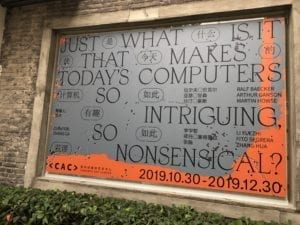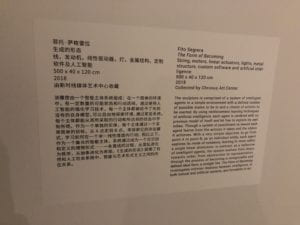Chronus Exhibition
Chronus Exhibition interests me by its feature that all of the artwork exhibits are based on some kinds of advanced technologies. As the ideology conveyed by this exhibition, the technologies evolve nowadays make people confused. What are our connections with these machines? “Just what is it that makes today’s computers so intriguing, so nonsensical?”Comparing to the traditional art form, such as drawings, the devices in Chronus Exhibition are moving. Comparing to films, they are three-dimensional. These features make the ideologies better conveyed to the audience in a rather direct way but the form itself is still an art. Besides the ideologies that the exhibition conveys, what differentiates the exhibition with other pure art exhibitions is the interaction is inside of the machine itself but brings reflection to the audience. 
There is only one device called Artificial Intuition that is directly interactive. According to the audience’s position and whether they are moving or not in front of the sensor, the plastic, black tentacles move and scratch. However, the subjects of interaction may not be a human being. This idea is clearly revealed by showing the interaction within the well-developed, advanced, intriguing machines. For instance, The Form of Being is a device that is comprised of “a system of intelligent agents in a simple environment with a defined number of possible states to be in and a choice of actions to be exerted”. There may be no interaction for the device with the audience. Nevertheless, inside the machine itself, there is a simple objective for each agent to achieve, with a system of punishment versus reward in the artificial intelligence program. By showing the process of agents’ movements, the audience is able to see how AI evolves by itself. It also reveals the process of learning, which is similar to our learning processes. The reflection of the audience is one of the most important parts of the interactive devices. Chronus Art exhibition achieves this and brings the question of technology into the audience’s minds.

Research
Besides the exhibition, I researched on several projects and exhibited artworks, but lots of the artworks were not interactive by my definition. Here are three of the most representative projects in my consideration.
First, the game B.U.T.T.O.N. (Brutally Unfair Tactics Totally OK Now), which is an interactive game based on four gamepads and one screen. Using four different characters to represent the players and giving the instructions through the screen, the player who holds the button on his/her gamepad for several seconds will win the game. The rules and the mechanism seem to be simple. However, the fun is not. The players will not only interact with the device but also the other three players, who may disturb and stop each other from the gamepads. This is definitely a successful interactive device. When we see people laughing when they are playing the game, we also get entertained through this process. It inspires me that the mechanism and the rule of the device itself have no need to be complex or too advanced. The most important idea behind the interactive device is too bring fun or improvement based on current technologies and understandings on particular events.
Second, Playing Wall Tetris is also an interactive game involving visualized and playable technologies. However, this one is not as successful as the BUTTON since it lacks improvement. Why not just play Tetris on your phone? Meanwhile, the visualization is not so comfortable. The lights of LED lights seem to be too strong that makes this Wall Tetris a little bit of annoying. This reminds me that the outfits of the interactive device need to be good for the audience because this is closely related to the experience they will have during the usage. Also, it reminds me of my midterm project, which is questioned by one of the teaching fellows that what is the meaning and the purpose to replace the Book of the Answer with this complex, huge device to get the answer. We see that if we want to build up a new interactive device, we must research on previous, existing devices and improve them.
The last one is an interactive video example. It is a successful interactive experience for me and this technology is applied in many films and video games. This is a way to get the audience involved in the situation and let them empathize with the situation. This inspires me that the interactive device we build must involves in something that can be reflective, empathetic, or fun.
Interaction
“Listening, thinking, and speaking” in human terms from Chris Crawford’s perspective and “input, processing, and output” in computer terms (XX). This is the first quote I use to interpret the term “interactive”. Since the beginning of the semester, we work on the definition and understanding of “interactive” and the understanding of mine changes a lot after making the group project and the midterm project. In the group project, what is interactive to me is ” a procedure of two or more objects affecting each other in various ways in a short period of time”. It adds a restriction on the original interpretation that the influence on the other object must be in a short period of time. It needs to be clear and obvious. In the midterm project “Boxes know the answer”, I adds “bring reflections and new understandings on some bigger, theoretical questions for the audience” into the definition of “interactive”. The significance of certain interactive devices needs to be clear so that the audience can understand the reason and the meaning of the author creating this project.
Using the words from Making Interactive Art: Set the Stage by TIGOE, Then Shut Up and Listen, “Don’t interpret your own work”. This is the most profound lesson I learned in the midterm project user testing session. It is hard to let the audience understand your original meaning and what you want them to do. So actually you need to carefully design your project, giving obvious implications and automatic feedback by the device itself instead of you. This is shown in the exhibition that the interactive inside of the device is understandable for the computer and in the game BUTTON, instructions and the rules of the game are clearly given by the screen. “Think of interactive artwork, don’t think of it as a finished painting or sculpture. Think of it more like a performance.” This is what TIGOE says about interactive devices, and what I understand about interaction.
Reference:
Crawford, Chris. “Art of Interactive Design.” Art of Interactive Design | No Starch Press, nostarch.com/interactive.htm.
http://www.tigoe.com/blog/category/physicalcomputing/405/
https://www.youtube.com/watch?v=Hki5YKPoOQY
https://www.youtube.com/watch?v=RRXkeP-lxWY
https://www.youtube.com/watch?v=aAOplz5ri5k&feature=youtu.be